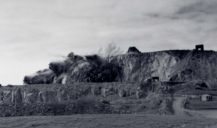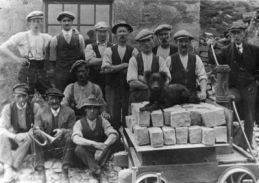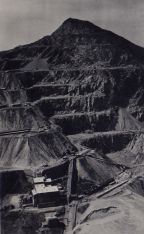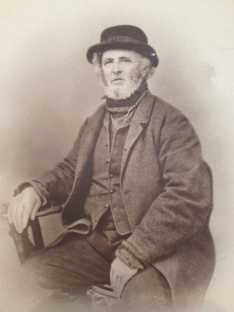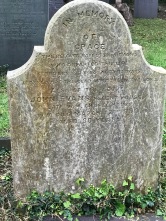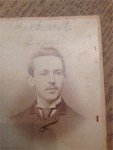This branch of the Evans family has its roots in North Wales. Today the area is known as Penmaenmawr but at the time of these ancestors it was variously called Capelulo, Penmaen, Penmaenan, or Dwygyfylchi.
This does complicate things when trying to track ancestors down!
There is a very good website:
http://www.penmaenmawr.com/historyVillageNames.html which explains the name in full. I include an extract here :
Origins of Dwygyfylchi 1772 when the Caernarvonshire Turnpike Trust built a new road from Conwy to Bangor as part of the general improvement to roads in the county in the second half of the eighteenth century. The Trust chose a route through the Sychnant Pass, thus avoiding the precipitous Penmaenbach. This was a tortuous journey for man and beast and both needed refreshment and rest before or after negotiating the steep Pass. Therefore, a small village developed at the foot of the Sychnant to provide for the needs of the travellers. Soon, three inns, the Red Lion, the Cross Keys and the Horseshoe were built, plus a smithy and a number of cottages in which tradesmen and others serving the travellers lived.
In the 1830s the quarries on the slopes of Penmaen Mawr mountain began operating. The first workers were housed in cottages immediately below the first workings and so was born another village within the parish — Penmaenan, a village that was to grow rapidly in the next twenty years while Capelulo was to remain unchanged. Again, the inhabitants of Penmaenan, like those of the older village, were to be ‘registered’ as members of the ecclesiastic division of Dwygyfylchi. So now we have two villages within the parish of Dwygyfylchi, but after 1850 the confusion really begins.
In 1848 the railway came through the parish but it was not until 1850/51 that a station was constructed here. The railway company, The Chester-Holyhead Railway Company, decided to call the new station, Penmaenmawr! They called the station at Conwy – Conwy, they called the station at Llanfairfechan – Llanfairfechan, but the station at Dwygyfylchi they called Penmaenmawr. Why?
So now we have Penmaenan in the West, Capelulo to the East and Penmaenmawr /Panyrafon in the middle. In passing it is interesting to note that the postal address for the district in these early days was “Dwygyfylchi, near Conwy”!
Towards the end of the century the name Dwygyfylchi slowly but surely went out of fashion. It was Penmaenmawr that now ruled. Because of the station name, guide books called the area Penmaenmawr and so did the Post Office.
To these Victorian gentlemen ‘Penmaenmawr’ was synonymous with progress, ‘Dwygyfylchi’ with none. so gradually Penmaenmawr became the accepted name.
Our history
A family member went to the Penmaenmawr area many years ago to research the history of this Evans family.
I have found no digital proof of these early Evans but my husband’s cousin, Robert Parker was a through and detailed man. He visited local record offices and churches in the areas of interest and documented all he found. He sent me photocopies and hand written copies of all that he found ( in the days before laptops etc!) .
So I have used the information he gave me and accepted it as the start of the history.
RICHARD EVANS
The earliest Evans identified by Robert Parker was Richard Evans, born in 1725 and he died on 6 Jun 1762.
There is no record of a marriage and only one child named Richard is recorded.
This Richard was born in 1768, and on his birth record were the words Cross Keys
Now Cross Keys is not a village I can trace in Caernarfonshire but it is a pub name in Dwygyfylchi from about the 1770s
According to Robert, Richard’s death was 16 Nov 1805, in Wales but not sure about this as I have found another record for Richard Evans in 1808 in Wales. These early records did not give much detail as they were usually taken from church parish records so although it says just Wales we know the they were the parish records from the local churches.
Richard married Mary Hughes who was born on 5 May 1768, Dwygyfylchi, Wales Her Father was Hugh Jones Hughes (1725-) and her Mother was Ellen Jones (1725-)
She died on 6 Nov 1805, in Dwygyfylchi, Caernarfonshire.
Her place of death appears to be given as Cross keys so that may bear out that it is in fact a pub in Dwygyfylchi and not a village elsewhere. Perhaps it was a hostelry originally run by Richard’s parents which is why Richard was born there and then Mary and Richard continued to run it as a hotel and inn ?? Just conjecture.
They had 3 Children as far as I can tell : Hugh, Eleanor and John
I cannot trace Hugh at all but Robert Parker obviously did so I have included him here. Birth date was 8 Sept 1787. Mary’s father was Hugh so that would seem to follow. As there is a huge gap before the next child, Eleanor, was born perhaps Hugh was born before Richard and Mary married? I cannot trace a marriage date.
Eleanor was on 13 May 1800 and I have traced the record of her christening :
Eleanor Evans : Christening Date 28 May 1800 : Christening Place St Nicholas Church, Liverpool : Father’s Name Richard Evans Mother’s Name Mary Hughes
John was born in1802, again baptised at St Nicholas Church, Liverpool, England. Father’s name was Richard Evans and mother was Mary Hughes. His christening record states that his birth date was 10 May 1802 and his baptism date was 26 Jan 1810 . This is a long gap between birth and christening but sometimes that did happen.
Why the baptisms were in St Nicholas Church Liverpool I do not know. According to the 1851 census return his birthplace was Liverpool. Unless Mary Hughes had a connection, but she was born in Dwygyfylchi . Or perhaps Richard ? Something to maybe discover later.
We are now beginning to get more confirmed places and dates. John married Grace Williams on 12 Apr 1830, Llanfairfechan, Caernarfon. Llanfairfechan was a small community a few miles down the road from Dwygyfylchi. Grace was born in 1809, in Llanfairfechan, Caernarvonshire so was about 21 when she married John.
The Bishops transcript states that John and Grace were married by banns. The service conducted by Curate Edward Herbert. Both parties signed their names and the witnesses were John Jones, Elias Williams and added on the end of the entry and next to the signatures of the two witnesses is the note “x – the mark of Catherine Williams”.
I presume the two Williams’ were relatives of Grace?? Robert Parker mentions a book by Elizabeth C Ellis “Fresh as Yesterday : memories of old Llanfairfechan” in which Elias Williams and Katherine Williams are mentioned.
John had several different jobs – the first mention of his occupation was documented as working as a labourer, living at Plas on the birth of his son Richard, and still a labourer, but now living at Pendref ( or possibly Pentref) when Mathias was born in 1832.
By the 1841 census John is a quarryman, living with Grace and 3 of his children in Peny Mainan – which could be Penmaenan?
The ancient quarry had been replaced by a newer quarry in the 1830’s. In those days Penmaenmawr stone was carried by tramway to loading jetties on the seashore, from where it was taken by ship to Liverpool and other major ports, then by canal or road to its final destination. With the coming of the railway to Penmaenmawr in the 1840’s, the shipping trade fell into a decline from which it never recovered. I presume John worked kidding out the stone.
Life was not easy for the quarrymen, especially those who worked on the higher slopes. They were expected to walk up to the summit area in all weathers and faced losing pay if unable to reach the top. A strong spirit of camaraderie developed and was reflected in the town’s chapels, pubs and cultural societies.
Without a doubt though, for those not even working in the quarries but living in Penmaenmawr and nearby villages, their lives were affected by the quarry. The fine grey dust was inevitable – results of the activity in the stone crushing mills and being carried up on open conveyor belts. As the wind regularly changed direction, the dust spread and impartially laid a grey white coat on the dwellings of great and humble alike. It could find a line of washing or a polished windowsill with unerring accuracy within a radius of two miles around the quarry and penetrated even the most skilfully sealed house.
All his neighbours on the the 1851 census are quarrymen so maybe the housing was provided by the quarry.
At this time the population of Penmaenmawr was about 850. But the quarry was growing and the population increasing as the quarry was attracting workers from all around. . By 1900 the population was over 3,400
Perhaps John could see the writing on the wall and realised that more people meant more opportunity for other businesses. These extra families would have to eat.
So by 1851 John had left the quarry and was now a flour dealer and grocer. His address is Pen- y -Maenag, and is living with Grace and just two of their children at home
He was still a flour dealer in 1853 as was recorded on his son Mathias’ marriage certificate.
From the various censuses John appears to have had many trades as mentioned above – quarryman and flour dealer but then later, grocer, and iron worker.
The census of 1861 shows us he was a retired iron worker. Where the iron works were I do not know but he was living at Chapel House, Brynmainar, Dwygyfylchi. No children living at home now.
And then in 1871 he calls himself a land owner but is still living at Chapel House, Brynmainar, Dwygyfylchi – just himself and his wife Grace at the address at this time .
In about 1877 Mathias, his son, and his family moved into Regents House in Pant y afron. Pantyafron gradually became the centre for shops and businesses. Mathias ran a drapers shop. As far as I can tell John himself did not live in Regents House unless it was for short periods between censuses.
But there was a connection as “late of Regents House” was mentioned on his probate records. Mathias and his family were the first tenants of Regents House having moved there from Lewis House, Penmaenan. But by 1881 Mathias had moved to Manchester and a different family were living in Regents House.
Things had also changed for John by the 1881 census. We find him still living at Chapel House, Brynmainar Dwygyfylchi. but with his grand daughter Grace Anne. His occupation is stated as a retired grocer. His wife Grace had died on 18 February 1880 and Grace Anne had moved in as his housekeeper. perhaps he was more infirm and needed practical help. He was obviously close to Grace Ann as he leaves her his entire estate.
John died on March 17 1890 and is buried, with his wife Grace in Dwygyfylchi churchyard
The Probate record states :
John Evans Formerly of the Wesleyan Chapel House Penmaenan late of Regents House, Pant – yr- Afon, Penmaenmawr…. probate was granted to Grace Ann Evans of Regent House, Spinster, grand daughter a sum of £1,110.6s
John and Grace had 4 Children : Richard (1830-1867), Mathias (1832-1882), John (1836-) and Elizabeth (1836-)
Richard was baptised on 6 Jun 1830 in Llanfairfechan, with Edward Herbert conducting the service. This was their first child.
In 1841 he was living with his parents at Peny Mainan (Penmaenan?), aged 11. Ten years later in 1851 he was still living at home with the family and seemed not to be working as he is described as “at home”
However by 1861 Richard , aged 31 was married and living with his wife Mary in Penmaenan and was a grocer. They had 3 servants living with them at this time so the business was obviously successful. However the 1861 census just gives the address as Penmaenmawr so I am not sure where the shop was.
He died on 16 January 1867 and was buried on 19 January 1867, in Penmaenmawr. Mary, his widow was granted probate and his estate was under £1,500.
Robert Parker’s research shows his wife may have been Mary Hayes as an earlier family tree shows this. I cannot trace a marriage to confirm this. Neither can I find a Mary Hayes born about the right time. According to Robert Parker’s research, Mary was born in Brymho, Denbighshire. No record of that so far.
However the various censuses record Mary as being born in Hope,Flintshire, Wofa, Denbighshire and then Brymho, Denbighshire. I have tried all these places with little success for a birth or a marriage.
However I did find a record for a Mary Jones marrying a Richard Evans on 21 Aug 1851 in Brymho, Denbighshire.
Just to add further confusion there was a Mary Amy Clark Hayes who did marry a Richard Evans in 1890! But this Richard was the nephew of the above Richard. So this maybe a confusion of names, dates and places by the researchers!
Richard and Mary had the following children: John (~1853-) Hugh (1855-) Hannah G (1857-) Richard (1860-) Elizabeth (~1863-)and Edward L (~1865-)
The next child born to John and Grace was Mathias in 1832.
Mathias and his family are recorded on a separate page in this story. Mathias was a direct ancestor and we have a lot of information on his descendants.
The other children of John and Grace are harder to follow.
John was born after Mathias and his baptism was on 26 December 1836, again in Llanfairfechan.
John’s life is a bit sketchy as I can trace him at home with the family in 1841 but after that he seems to disappear.
Family lore says that John left home when he was quite young and went to sea. Becoming a ship’s captain eventually. No proof of this.
The other child of Grace and John was Elizabeth. I can only find a trace of her in 1851 census which gives her age as 15. This would make her birth around 1836. This is the same year as her brother John so I think her age is slightly out. So she may in fact be older or younger than John. As I have found proof of his baptism if they had been twins I feel she would have been there too.
This story is not complete as there are many gaps and uncertainties with people and places but for the time being we can continue with Mathias and his family.



